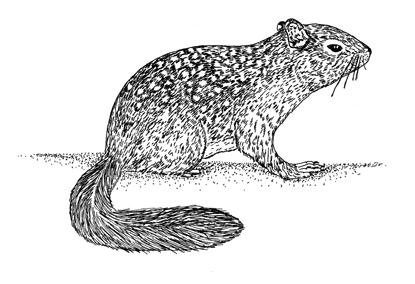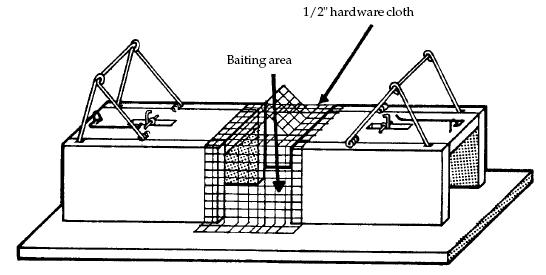 Rock Squirrels - September 1, 2004 Jeff Schalau, County Director, Agent, Agriculture & Natural Resources Arizona Cooperative Extension, Yavapai County  Rock squirrels (sometimes called ground squirrels) are found in many areas of Arizona. Their burrowing and feeding activity can be disruptive, annoying, damaging to landscape and garden plants, and even hazardous to human health. Of the several species of squirrels found in Arizona, the rock squirrel (Spermophilus variegatus) is the most likely to be found burrowing around homes and gardens in north central Arizona. Rock squirrels are relatively large, heavy-bodied, and have moderately long, bushy tail. The head and body are about 10.5 inches long and the tail is approximately 8 inches. Their fur is usually brownish gray and mottled with white spots. Rock squirrels (sometimes called ground squirrels) are found in many areas of Arizona. Their burrowing and feeding activity can be disruptive, annoying, damaging to landscape and garden plants, and even hazardous to human health. Of the several species of squirrels found in Arizona, the rock squirrel (Spermophilus variegatus) is the most likely to be found burrowing around homes and gardens in north central Arizona. Rock squirrels are relatively large, heavy-bodied, and have moderately long, bushy tail. The head and body are about 10.5 inches long and the tail is approximately 8 inches. Their fur is usually brownish gray and mottled with white spots.Rock squirrels live in open burrows (as opposed to a gopher’s closed burrow system) and prefer rocky areas, but often burrow under human-made structures, irrigation ditch banks, and the edges of cultivated fields. They are active during daylight hours, usually eat plant matter, but occasionally eat insects and road killed animals. Rock squirrels need very little free water obtaining what the need from dew, succulent vegetation, bulbs, and bark. They hibernate in colder areas and emerge in spring to feed on green vegetation. As spring growth dries up, they begin to feed on seeds and fruits of plants including acorns, juniper berries, pine nuts, mesquite buds and beans, cactus, and other native plants. Rock squirrels have cheek pouches and will horde and cache food. Rock squirrel mating season is between March and July and after a 30 day gestation period, a litter of 5 to 7 pups are born. One litter is produced per year. The pups are born hairless and raised in a nest of grass inside the burrow for about 6 to 7 weeks before they venture above ground. Rock squirrel burrows protect them from weather and predators. The burrow system is expanded each year and multiple entrances are common. Burrows entrances are serious trip hazards and should not be allowed to exist in equestrian areas, parks, schools, and other public areas. The burrows often extend under sidewalks, dwellings, and outbuildings where they can weaken structural integrity. Rock squirrels are also associated with transmission of bubonic plague to humans. For these reasons, property owners and public organizations should not allow them to exist where they pose unnecessary risks. As with many pest problems, an integrated approach using multiple control methods will be most effective. Fences are generally ineffective in excluding ground squirrels. Low electrical fences have been effective near agricultural fields but must be kept clear of weeds. Habitat modification can discourage them from becoming established. Removal of debris piles, irrigation pipe, pallets, and rock piles can discourage rock squirrels. Frightening and repellents do not deter rock squirrels. Shooting is not recommended for safety and legal reasons. Toxic baits and fumigants can be very effective. However, these products are best used by licensed pesticide applicators to prevent harm to non-target species.  Trapping can be used by do-it-yourselfers. It is most effective on small populations and can be done any time rock squirrels are active (other than when they rearing young - for humane reasons). The best time to trap is prior to breeding in the spring. A proven design uses two box-type gopher traps fastened to a board end-to-end with a hardware cloth bait compartment between the traps (see illustration on the Backyard Gardener Web Site). Traps can be baited with walnuts, almonds, orange slices, or pieces of melon. It is recommended to leave the traps baited, but not set for a few days to allow the squirrels to become used to the traps and bait. Always wear disposable latex gloves when handling and disposing of deceased squirrels and be aware of local reports of plague. Once the squirrel population has been controlled, always destroy the burrow system to prevent reestablishment. Trapping can be used by do-it-yourselfers. It is most effective on small populations and can be done any time rock squirrels are active (other than when they rearing young - for humane reasons). The best time to trap is prior to breeding in the spring. A proven design uses two box-type gopher traps fastened to a board end-to-end with a hardware cloth bait compartment between the traps (see illustration on the Backyard Gardener Web Site). Traps can be baited with walnuts, almonds, orange slices, or pieces of melon. It is recommended to leave the traps baited, but not set for a few days to allow the squirrels to become used to the traps and bait. Always wear disposable latex gloves when handling and disposing of deceased squirrels and be aware of local reports of plague. Once the squirrel population has been controlled, always destroy the burrow system to prevent reestablishment.The question of live traps always comes up. Live traps can be used, but the trapped animal should be humanely euthanized. When animals are released in other areas they can become someone else’s problem or they are unfamiliar with the release area and are highly subject to death from predators or starvation. Transporting the animal can also stress it or increase risks of human exposure to disease. The University of Arizona Cooperative Extension has publications and information on gardening and pest management. If you have other gardening questions, call the Master Gardener line in the Cottonwood office at 646-9113 ext. 14 or E-mail us at mgardener@verdeonline.com and be sure to include your address and phone number. Find past Backyard Gardener columns or submit column ideas at the Backyard Gardener web site: http://cals.arizona.edu/yavapai/anr/hort/byg/. |